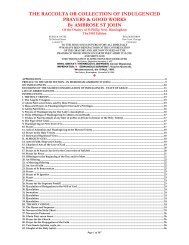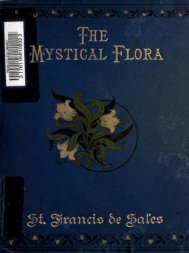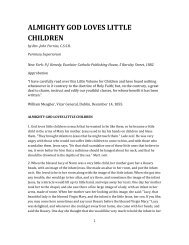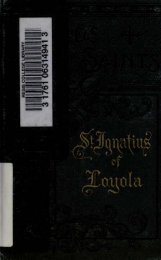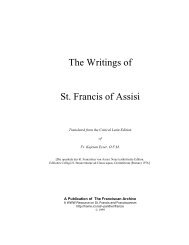Saint Anthony Mary Claret - Catholic Apologetics Information
Saint Anthony Mary Claret - Catholic Apologetics Information
Saint Anthony Mary Claret - Catholic Apologetics Information
Create successful ePaper yourself
Turn your PDF publications into a flip-book with our unique Google optimized e-Paper software.
documents. Moreover, to provide a notion of the <strong>Saint</strong>'s life between 1865 and his death in<br />
1870, a selection from his Correspondence and the Resolutions that he made during the last<br />
years of his life has been included. An account of the <strong>Saint</strong>'s death has been drawn from a text<br />
by an eyewitness, Father Jaime Clotet, who was very close in spirit to the Founder.<br />
How to Read the Autobiography<br />
1. Try to cut through the surface of the work.<br />
The Autobiography was written over a century ago, and feelings and attitudes have changed<br />
profoundly as the world has passed out of the romantic era into an age of existentialism and technology.<br />
Moreover, it has already been noted that the <strong>Saint</strong> himself regarded the manuscript as no more<br />
than a rough draft that needed to be corrected and retouched before it could be published. A large<br />
number of repetitions and mistakes can be attributed to his haste in writing. Add to this the difficulty he<br />
experienced in Castilian, since for many years he had spoken, preached, and written in Catalan.<br />
Nevertheless this rapid, careless style, free of all artifice, affords a very high degree of authentic personal<br />
contact with the author.<br />
2. Try to grasp the author's point of view.<br />
When St. <strong>Anthony</strong> wrote his Autobiography, he was writing precisely in his role as founder for<br />
the Missionaries of his Congregation. The work was written, then, with an expressly formative end in<br />
view. He uses the witness of his own life to initiate his readers into a glimpse of the Holy Spirit's action<br />
in the process of forming a missionary, from the beginning of his call to its fulfillment. Because of his<br />
charism as a founder, this action of the Holy Spirit manifested itself with the special intensity required of<br />
one who was to become the leader and model for all those men who were to identify themselves with<br />
him and his work.<br />
In writing of his vocation, he shows us how nature and grace predisposed him to follow<br />
the path that led him from the explicit opening call of "siempre, siempre," when he was a boy<br />
five years old, to the day of his ordination to the deaconate.<br />
He also gives us a description of his process of formation for the priesthood in general and for<br />
the ministry of the Word in particular. This he does in the account of his voyage to Rome and his stay<br />
there, as well as in the report of his initial experiences as a missionary up to the year 1840 when he left<br />
the stability of the parish to begin his ceaseless missionary journeys.<br />
At the outset of his career as an itinerant missionary in Catalonia and the Canary Islands, the<br />
Holy See granted St. <strong>Anthony</strong> <strong>Mary</strong> <strong>Claret</strong> the title of "Apostolic Missionary." The <strong>Saint</strong> came to look<br />
on this title as his own essential definition, which was enriched, as time passed, with the characteristic<br />
elements of his own charism. As a missionary his life was dedicated to evangelization and the prophetic<br />
ministry of the Word; hence, he did his utmost to avoid other functions of the ministerial priesthood such<br />
as administering the sacraments from a fixed base and on an established timetable. In itself, the<br />
designation "apostolic" simply referred to the Holy See, which had bestowed it on him, but <strong>Claret</strong><br />
applied it to himself in the deeper sense of a distinct way of life: an apostolic life in the manner of the<br />
Apostles--a life of the strictest evangelical poverty shared in brotherhood with those God-given<br />
companions who were moved by the same Spirit.<br />
These two essential traits, "apostolic" and "missionary," are a description of his very life, lived<br />
according to the special nuances of his own charism. This meant for him living the mystery of Christ, the<br />
Son who was sent as Master and Redeemer, the head and model of all missionaries. His only<br />
preoccupation was to follow and imitate Jesus Christ in prayer, work, and suffering and to seek always<br />
and only the glory of God and the salvation of men. It meant, furthermore, living the mystery of <strong>Mary</strong>,<br />
the Woman through whom the Son became man when He was sent to us (Gal. 4:4): <strong>Mary</strong>, the Mother of<br />
Christ, the Missionary, and mother of all missionaries in Christ; <strong>Mary</strong>, who became a mother through<br />
love, through her heart. <strong>Claret</strong> felt that it was in the furnace of this love that he was shaped into a being<br />
of charity that lights and kindles wherever it goes.<br />
4





